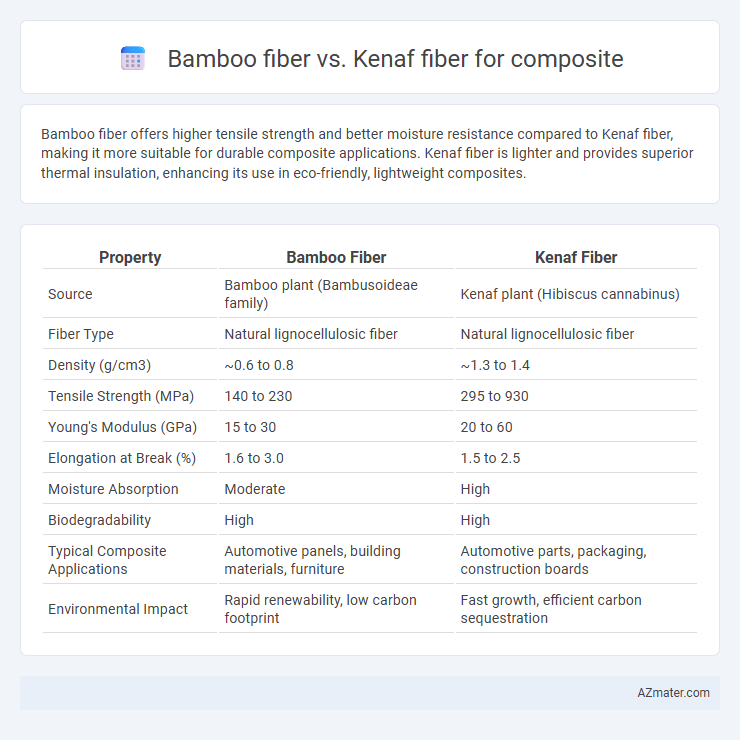Bamboo fiber offers higher tensile strength and better moisture resistance compared to Kenaf fiber, making it more suitable for durable composite applications. Kenaf fiber is lighter and provides superior thermal insulation, enhancing its use in eco-friendly, lightweight composites.
Table of Comparison
| Property | Bamboo Fiber | Kenaf Fiber |
|---|---|---|
| Source | Bamboo plant (Bambusoideae family) | Kenaf plant (Hibiscus cannabinus) |
| Fiber Type | Natural lignocellulosic fiber | Natural lignocellulosic fiber |
| Density (g/cm3) | ~0.6 to 0.8 | ~1.3 to 1.4 |
| Tensile Strength (MPa) | 140 to 230 | 295 to 930 |
| Young's Modulus (GPa) | 15 to 30 | 20 to 60 |
| Elongation at Break (%) | 1.6 to 3.0 | 1.5 to 2.5 |
| Moisture Absorption | Moderate | High |
| Biodegradability | High | High |
| Typical Composite Applications | Automotive panels, building materials, furniture | Automotive parts, packaging, construction boards |
| Environmental Impact | Rapid renewability, low carbon footprint | Fast growth, efficient carbon sequestration |
Introduction to Natural Fiber Composites
Natural fiber composites utilize renewable fibers like bamboo and kenaf to enhance mechanical properties and sustainability in material applications. Bamboo fiber offers superior tensile strength and growth rapidity, making it ideal for lightweight structural composites. Kenaf fiber provides excellent impact resistance and biodegradability, often favored in automotive and packaging industries where environmental impact is critical.
Overview of Bamboo Fiber Properties
Bamboo fiber exhibits high tensile strength, excellent flexibility, and low density, making it a superior reinforcement material for composites compared to many natural fibers. Its cellulose content ranges between 55-65%, contributing to enhanced mechanical properties and biodegradability in composite applications. The fiber's natural antimicrobial properties and rapid growth rate also position bamboo as an eco-friendly and sustainable option in composite manufacturing.
Overview of Kenaf Fiber Properties
Kenaf fiber, derived from the Hibiscus cannabinus plant, exhibits high tensile strength ranging from 400 to 800 MPa, making it suitable for composite reinforcement. Its lightweight nature, with a density of approximately 1.4 g/cm3, combined with excellent biodegradability and thermal stability up to 220degC, provides advantageous mechanical and environmental performance in composite materials. Kenaf's cellulose content, typically around 45-57%, contributes to its stiffness and durability, outperforming many natural fibers in composite applications.
Mechanical Performance Comparison
Bamboo fiber exhibits higher tensile strength and modulus compared to kenaf fiber, making it more suitable for load-bearing composite applications. Kenaf fiber offers better impact resistance and elongation at break, enhancing composite flexibility and energy absorption. Both fibers provide sustainable reinforcement options, but bamboo fiber's superior mechanical properties often lead to improved structural performance in composites.
Environmental Impact and Sustainability
Bamboo fiber and Kenaf fiber both offer significant environmental benefits as sustainable alternatives to synthetic fibers in composites. Bamboo grows rapidly, requires minimal pesticides, and sequesters large amounts of carbon, while Kenaf absorbs CO2 at a rate up to 2.3 times faster than an equivalent area of tree plantation, contributing to carbon footprint reduction. Both fibers are biodegradable, renewable, and promote eco-friendly composite manufacturing, but bamboo's faster growth cycle generally leads to a lower environmental impact over time.
Processing and Fabrication Techniques
Bamboo fiber offers superior flexibility and strength during composite fabrication, allowing for efficient thermoforming and resin infusion processes. Kenaf fiber requires specialized alkali treatment and careful moisture control to enhance fiber-matrix adhesion and prevent degradation in composite molding. Both fibers benefit from tailoring fiber orientation and surface treatments to optimize mechanical properties and compatibility in polymer composite manufacturing.
Cost Analysis and Market Availability
Bamboo fiber offers a cost-effective solution due to its rapid growth rate and abundance, making it readily available in major Asian markets, while Kenaf fiber, though slightly more expensive, benefits from strong cellulose content and is widely cultivated in North America and Africa. The low processing cost of bamboo fiber results from established extraction methods, whereas Kenaf's relatively new industrial adoption leads to higher initial costs but growing market demand. Market availability favors bamboo fiber for large-scale composite manufacturing, while Kenaf fibers are preferred for specialized applications requiring superior mechanical properties despite their premium price.
Applications in Industry
Bamboo fiber exhibits high tensile strength and excellent flexibility, making it ideal for automotive interior panels, construction materials, and biodegradable packaging composites. Kenaf fiber, with superior impact resistance and thermal stability, is widely used in paper production, insulation materials, and reinforced polymer composites in construction and automotive sectors. Both fibers contribute to lightweight, sustainable composite solutions but differ in mechanical properties that influence their specific industrial applications.
Challenges in Composite Development
Challenges in developing bamboo fiber composites include variability in fiber quality, high moisture absorption, and poor interfacial bonding with polymer matrices, which compromise mechanical properties. Kenaf fiber composites face issues related to fiber dispersion, thermal degradation during processing, and inadequate fiber-matrix adhesion, limiting durability and performance. Both fibers require advanced surface treatments and compatibilizers to enhance composite integrity and overcome these development hurdles.
Future Trends and Research Directions
Bamboo fiber and kenaf fiber are gaining significant attention in composite materials due to their sustainability, high strength-to-weight ratios, and biodegradability. Future trends emphasize enhancing fiber-matrix compatibility through surface treatments and developing hybrid composites combining both fibers to optimize mechanical and thermal properties. Research directions focus on nano-scale modifications, lifecycle assessments, and scalable processing techniques to improve performance and commercial viability in automotive and construction applications.

Infographic: Bamboo fiber vs Kenaf fiber for Composite
 azmater.com
azmater.com